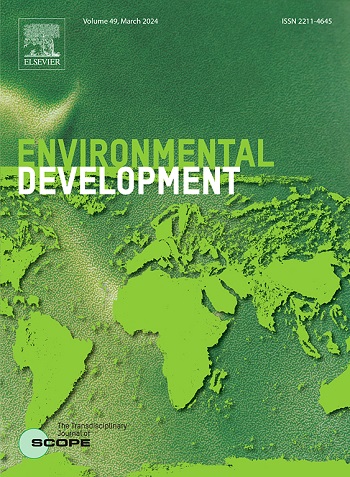Integrating ecosystem services into the water-energy-food-environment (WEFE) nexus for informed conservation strategies and planning in the Upper White Nile basin
IF 4.7
2区 环境科学与生态学
Q2 ENVIRONMENTAL SCIENCES
引用次数: 0
Abstract
This study explores the integration of ecosystem services within the water-energy-food-environment (WEFE) nexus framework to inform conservation and development planning in the Upper White Nile basin in East Africa, an area faced with interconnected socio-ecological and climatic challenges. Employing a multi-method approach combining stakeholder valuations and biophysical mapping, we assess the spatial distribution of WEFE-related ecosystem services across the basin and compare them to current conservation measures. Findings reveal a heterogeneous distribution of ecosystem services across the basin, with environment-related services, such as carbon sequestration and environmental quality, dominating spatially (56 %), particularly in the northeastern part of the basin, while food-related services (27 %) are concentrated in the western and eastern regions. Water-related services (15 %) show highest delivery around major lakes, whilst stakeholder valuations highlight the importance of water provision, artisanal fisheries, and biodiversity across all sectors. Analysis of current protected areas indicates their moderate effectiveness in conserving key ecosystem services, with better representation of environment (17 %) and water-related services (12 %) than food (8 %) and energy services (5 %). We identified critical conservation-development conflict zones along the Uganda-Kenya border and in Rwanda-Burundi, where competing priorities for WEFE resources require integrated management approaches. Our conservation gap assessment shows significant shortfalls in meeting international protected targets, particularly for energy and food-related services, which is most pronounced in Rwanda and Burundi. Our study underscores the value of integrating ecosystem services into the WEFE nexus framework for comprehensive conservation planning, highlighting how combining biophysical mapping with stakeholder engagement can inform targeted interventions that balance ecosystem protection with sustainable development in transboundary basins.
将生态系统服务整合到水-能源-食物-环境(WEFE)关系中,以便在白尼罗河上游流域制定明智的保护战略和规划
本研究探讨了水-能源-食物-环境(WEFE)关系框架内生态系统服务的整合,为东非白尼罗河上游流域的保护和发展规划提供信息,该地区面临着相互关联的社会生态和气候挑战。采用利益相关者评估和生物物理制图相结合的多方法方法,我们评估了wefe相关生态系统服务在整个流域的空间分布,并将其与当前的保护措施进行了比较。研究结果表明,生态系统服务功能在流域内分布不均,与环境相关的服务功能(如碳封存和环境质量)在空间上占主导地位(56%),特别是在流域东北部,而与食物相关的服务功能(27%)集中在西部和东部地区。与水有关的服务(15%)在主要湖泊周围的交付量最高,而利益相关者的估值强调了供水、手工渔业和所有部门生物多样性的重要性。对现有保护区的分析表明,它们在保护关键生态系统服务方面的有效性一般,环境服务(17%)和水相关服务(12%)的代表性高于粮食服务(8%)和能源服务(5%)。我们确定了沿乌干达-肯尼亚边境和卢旺达-布隆迪的关键保护-发展冲突地区,在这些地区,争夺WEFE资源的优先事项需要综合管理方法。我们的保护差距评估显示,在实现国际保护目标方面存在严重不足,特别是在能源和粮食相关服务方面,这在卢旺达和布隆迪最为明显。我们的研究强调了将生态系统服务纳入WEFE综合保护规划联系框架的价值,强调了如何将生物物理测绘与利益相关者参与相结合,为跨界流域生态系统保护与可持续发展之间的平衡提供有针对性的干预措施。
本文章由计算机程序翻译,如有差异,请以英文原文为准。
求助全文
约1分钟内获得全文
求助全文
来源期刊

Environmental Development
Social Sciences-Geography, Planning and Development
CiteScore
8.40
自引率
1.90%
发文量
62
审稿时长
74 days
期刊介绍:
Environmental Development provides a future oriented, pro-active, authoritative source of information and learning for researchers, postgraduate students, policymakers, and managers, and bridges the gap between fundamental research and the application in management and policy practices. It stimulates the exchange and coupling of traditional scientific knowledge on the environment, with the experiential knowledge among decision makers and other stakeholders and also connects natural sciences and social and behavioral sciences. Environmental Development includes and promotes scientific work from the non-western world, and also strengthens the collaboration between the developed and developing world. Further it links environmental research to broader issues of economic and social-cultural developments, and is intended to shorten the delays between research and publication, while ensuring thorough peer review. Environmental Development also creates a forum for transnational communication, discussion and global action.
Environmental Development is open to a broad range of disciplines and authors. The journal welcomes, in particular, contributions from a younger generation of researchers, and papers expanding the frontiers of environmental sciences, pointing at new directions and innovative answers.
All submissions to Environmental Development are reviewed using the general criteria of quality, originality, precision, importance of topic and insights, clarity of exposition, which are in keeping with the journal''s aims and scope.
 求助内容:
求助内容: 应助结果提醒方式:
应助结果提醒方式:


